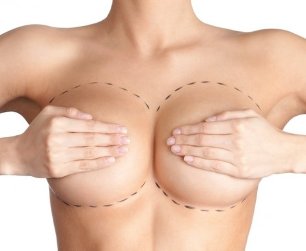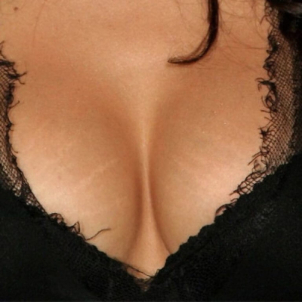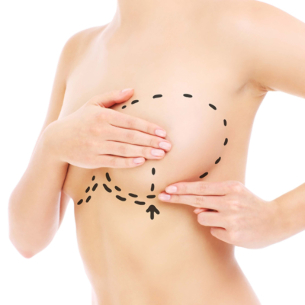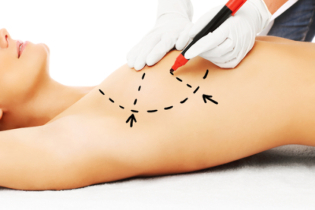
Ptosis or sagging of the breasts is a cosmetic problem that worries many women. It adds insecurity and his sexuality.
If a woman is worried about this, is embarrassed in front of her husband or boyfriend, a breast lift is worth trying.
This procedure should not be confused with breast augmentation with implants. The lifting aims to eliminate ptosis, giving the female breast a natural elasticity.
What is this procedure, what is it called?
A breast lift is called mastopexy.The procedure involves remodeling the mammary glands, giving them natural elasticity and an attractive appearance without the use of implants. The operation is performed with minimal surgery under local or general anesthesia.
The degree of ptosis plays an important role in its choice. There are 4 degrees of the disease. Appropriate steps are taken to make an accurate diagnosis. The degree of sagging is determined by the distance from the crease of the breast to the nipple.
Help!Ptosis is stage 1, 2, 3 and 4 and is measured by the distance between the crease of the breast and the nipple. Failure of 1-2 cm is considered non-critical and refers to grade 1.
If the nipple is 8 cm or more below the breast crease, a grade 4 ptosis is inserted. Here the surgeons have to cut a large amount of skin and fatty tissue and without general anesthesia this will be impossible.

Readings
The skin of the chest is sensitive to any changes in the body. There is no natural muscle structure underneath to maintain its shape. Therefore, it is difficult to keep its original shape throughout life. The reasons that led to the change in its shape are:
- A sharp increase or decrease in weight.The tight skin on the chest after losing weight loses its elasticity and appears flabby.
- Large breast.Breasts over 3 sizes fold under natural weight.
- Changes in the hormonal background.The lack or excess of hormones contributes to the swelling or "deflation" of the breast.
- Operations. For example, when a malignant tumor is removed, the glands become asymmetrical. In severe cases, the mammary gland becomes hollow and saggy.
- Age.The chest, which has no muscle support, loses its elasticity before the rest of the body.
- Wrong size bra.If it does not provide adequate support, the mammary glands will sag ahead of time.
- Breastfeeding.Milk-filled mammary glands can enlarge 3-5 times. After completing lactation, it returns to its original size, but not its shape.
- Congenital anomalies.Your breasts may not develop properly by the time of puberty. The only way out is to correct the shape.
Another problem with sagging breasts is that it is usually accompanied by stretch marks and sagging skin.
Contraindications, limitations
Breast lift involves surgery in the body. Each operation has its indications and contraindications. This type of operation is not prescribed in a number of cases:

- pregnancy or planning, as all the results of the operation will vanish;
- less than 12 months after the end of hepatitis B, this is how much the mammary glands need to recover from breastfeeding;
- presence of tumors in the chest area;
- acute infectious diseases;
- diabetes mellitus;
- renal failure;
- cardiovascular dystonia;
- minors under 18 (parental consent and medical emergencies required);
- obesity, which is a consequence of metabolic disorders and can cause complications after surgery.
Before deciding on a breast lift, it is necessary to evaluate the positive and possible negative consequences.
Views
Breast lift can be performed with or without surgery.In the first case, the method of excision of tissues is used according to various schemes, the second is the effect on the deep layers of the skin. It should be noted that non-surgical methods are best for preventing ptosis or in its early stage. Operational interventions help solve the problem in more advanced cases.
Endoscopic
Small areas of skin are incised in the lateral breast region.The endoscope and instruments are introduced through them. The tissue is removed from the inside, so the surgery after the scars have healed will be invisible.
This is one of the more expensive types of breast lift. The success of this procedure depends on the qualifications and experience of the doctor performing the operation. But the result will remain unchanged for 10-15 years. Endoscopic mastopexy can eliminate ptosis of any severity.
Periareolar (circular)
During thisoperation, the doctor cuts the excess tissue around the areola.In this way, you can not only tighten the mammary glands, but also change the diameter of the nipple. Traces after surgery and healing become invisible.
Among the drawbacks is the potential impact on breastfeeding. In addition, it is used only with 1 and 2 degrees of subsidence. After surgery, some patients have noticed a loss of sensation in the nipples.
Vertical

During surgery, the surgeon makes incisions over the breast and along the edges to lift the nipple.This method requires minimal intervention in the structure of the mammary glands and practically does not cause complications and maintains the natural shape of the breast. It can also help shrink the nipple.
This method is used in the early stages of ptosis. It cannot be used if there are already scars on the chest. It also won't help with severely sagging breasts.
Anchor (T-shaped)
Indicated for severe ptosis or large breasts that are uncomfortable. Surgerymakes an anchor or inverted T incision in the chest.Next, the surgeon cuts the excess tissue and the lower part is lifted upwards.
The operation has a pronounced aesthetic effect, it can be repeated until the patient is satisfied with the result. The disadvantages include the application of a large number of cuts. This increases the rehabilitation period and can cause complications.
Laser
This is a relatively new type of breast lift. It is widely used in the West, but in our country there are a small number of clinics with the necessary equipment.The laser can be used to lift and enlarge the breasts.This does not require the use of a scalpel.
Laser lifting is effective in the early stages of ptosis. It will take about 6 treatments to achieve the desired effect. They are performed with an interval of at least 14 days. The procedure does not require the introduction of anesthesia, as it is painless. In some cases, unpleasant sensations may occur.
Mesothreads
If the breasts have lost their former elasticity and cause internal discomfort in a woman, doctors recommend a mesothread implant procedure. It leaves no marks on the skin and has no complications.
While located in the mammary glands, thethreads gradually become covered with fatty tissue and create a support effect.The threads continue to work for 6-8 months, after which they absorb completely and do not require removal.

Non-surgical methods
Women with Grade 1 breast sagging are advised to use non-surgical breast lift methods. They help restore skin elasticity and return the mammary glands to their previous shape:
- Myostimulation - with the help of electrical impulses sent through the connected electrodes, the elasticity of the skin is restored and the stretch marks are eliminated.
- Lipolifting - transplantation of fatty tissue from the abdomen and inner thigh to the problem areas of the chest. It guarantees 100% engraftment of the adipose tissue.
- Microcurrents with serum - causes active production of elastin and collagen, accelerates cell renewal, reduces sutures and stretch marks.
- Mesotherapy.
The choice of the type of lifting is also influenced by the degree of stretching of the breast skin, its asymmetry and size. The surgeon will assess the general condition and select the safest and most effective option for each individual case.
Preparing for plastic surgery
Before obtaining permission from the surgeon for a breast lift,must consult with other specialists: gynecologist, therapist, mammologist and anesthetist.You will also have to pass a series of tests:
- general and biochemical blood test;
- blood test for diabetes mellitus;
- general urinalysis;
- analysis for hepatitis, HIV, syphilis;
- ECG;
- Breast ultrasound;
- mammogram;
- fluorography.
For 14 days before surgery and for the same period after, you should not smoke, take alcohol, drink drugs that affect blood density, including oral contraceptives. You should also give up strenuous physical activity. Immediately prior to the operation, no food should be consumed 12 hours prior to the operation. You can drink tea or water.
How to do it, is it dangerous?

How is the operation performed?Breast lift is safe.Start with a breast marking. The surgeon marks the incision sites and skin areas to be removed with a marker. Then the patient is given anesthesia. It can be of different types:
- intravenous;
- inhalation;
- local.
Stages of breast lift:
- the surgeon makes incisions along the marks;
- further shapes the final result and cuts off excess skin and adipose tissue;
- if necessary, the surgeon reduces the circumference of the nipples;
- After that, sutures and an antibacterial bandage are applied, drains are inserted (you can read more about what sutures are and how long they heal after the operation).
Duration of operation from 1, 5 to 3 hours.
What happens in the postoperative period?
- The patient regains consciousness almost immediately after the operation.Chest pains begin when we recover from anesthesia. The doctor who performed the operation should advise on analgesics and antibiotics to be taken in the postoperative period.
- 3 days after the mastopexy, the patient is observed in the hospital.If no complications arise, she is discharged. The doctor must evaluate the primary outcome, which is whether the stitches begin to tighten and whether there is asymmetry. After a week, the stitches are removed.
- Edema is observed for the first week after the operation.The chest looks like stone. In the first month, swelling persists, bruises may appear. After 1-3 months, they completely disappear, you can evaluate the result. During this time, the stitches will completely heal, the edema and hematomas will subside.
- Corrective underwear must be worn during the first six months, which will help keep shape, uses ointments that accelerate skin regeneration. This will help to overcome the rehabilitation period faster.
- Furthermore, within 6 months of the operation, you must not visit the bathhouse, the sauna,in order not to infect the open sutures. It is forbidden to go to the gym and lift weights - this contributes to the divergence of the seams.
Patients who decide to undergo breast lift should also be aware of possible complications. These include pain in the mammary gland area, bruises and hematomas, swelling at the incision sites, tissue inflammation, and loss of sensation.
Before and after photos

Later in the photo you will see what big breasts look like before and after a lift.
Cost of the procedure
The cost of the service depends on the type of intervention, the qualifications of the surgeon and staff, the state of the clinic. The price also includes a training program, purchase of corrective underwear, patches, anesthesia.
Breast lift is an opportunity for every woman to feel her sexuality and attractiveness again. But, before deciding on a serious step, you should study the information about this operation, compare the positives and possible risks, and only then make the final decision.
Mammoplasty is a type of surgery to correct the shape and size of the breast. The specialist changes the contour, the volume of the mammary glands, the shape of the nipples and areolas.



























